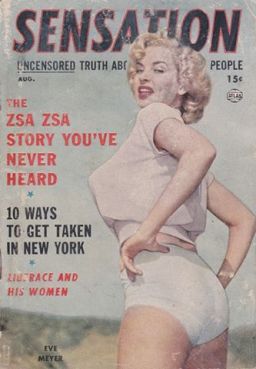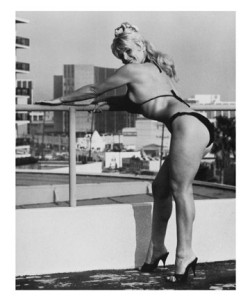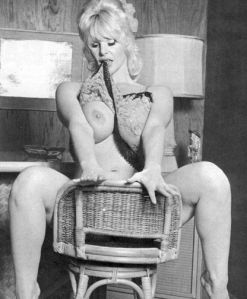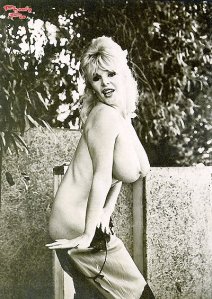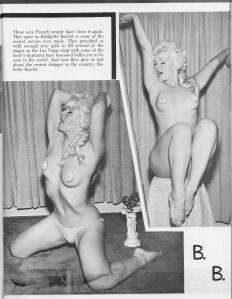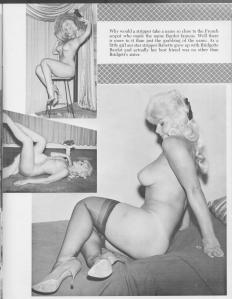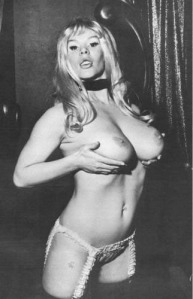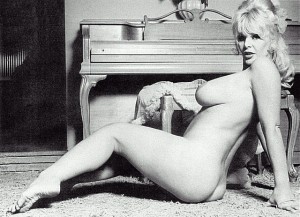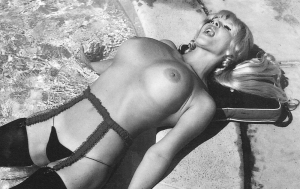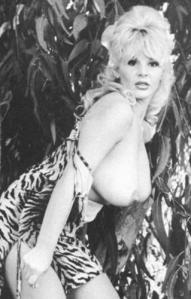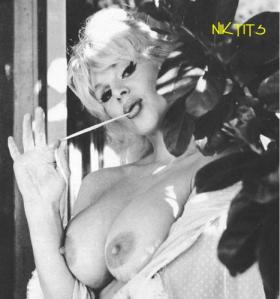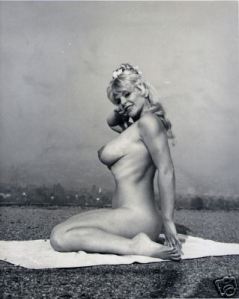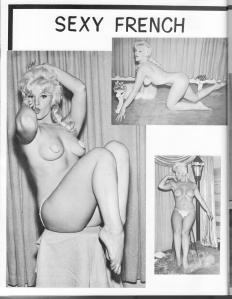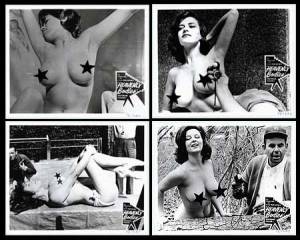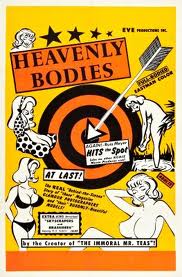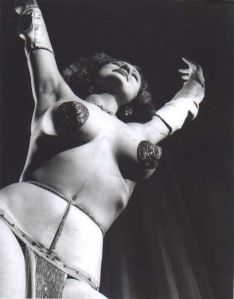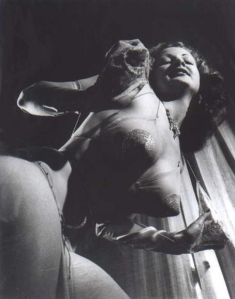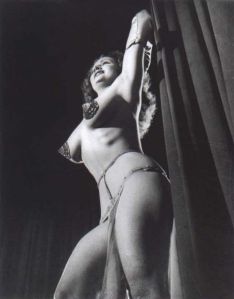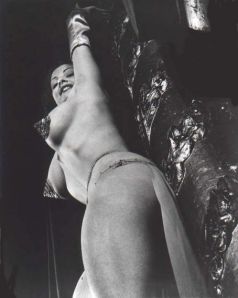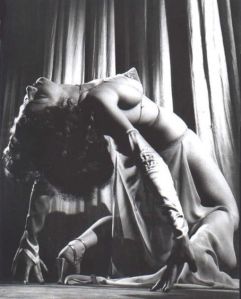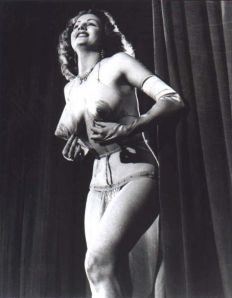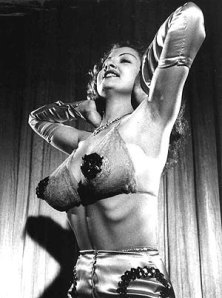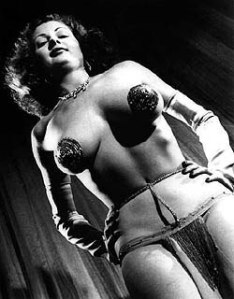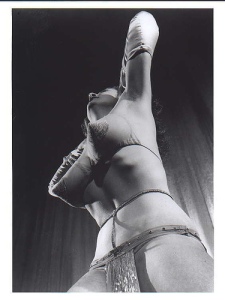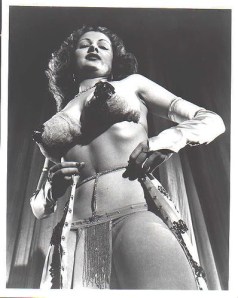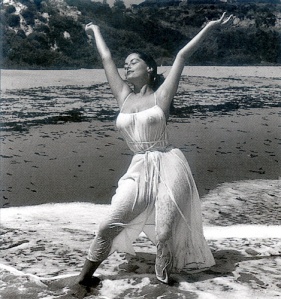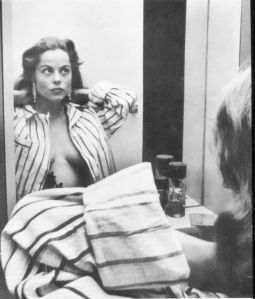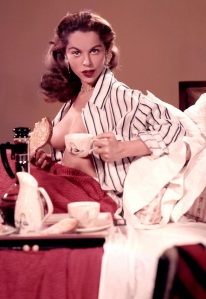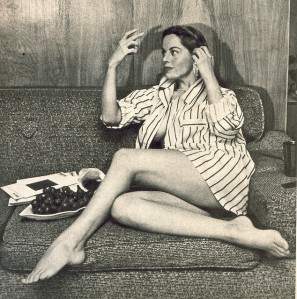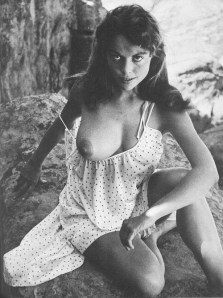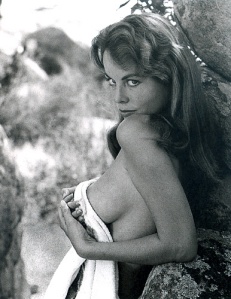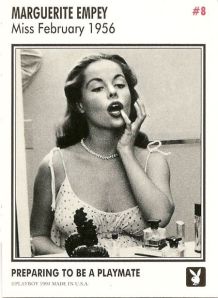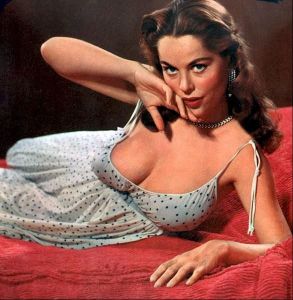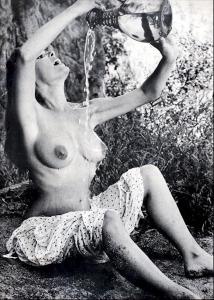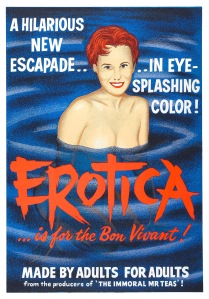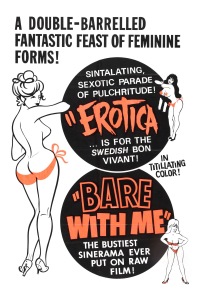Tags: Eve Meyer, Glamour photography, Photography, Pin up, Pin Up photography, Russ Meyer
Archive | Photography RSS feed for this section
MEYER MONTH – ‘Heavenly Bodies’ (1963)
26 Mar2012 saw another of Russ Meyer’s early films finally get a home viewing release for the first time, 1963’s Heavenly Bodies. This was one of the directors early films, alongside This Is My Body and Erotica, that had been out of circulation since its original 60s theatrical run. Like Meyer’s other early films, Heavenly Bodies is essentially a moving image pictorial, a brief glimpse at the life of a glamour photographer and the pin-up model at work. Opening with up close shots depicting the contours of the female body, or as Meyer has it in his narration ‘the component parts of a woman’, the picture eventually shows us the printing process of the glamour magazine before moving on to show different segments of various known photographers (Ken Parker, Fred Owens, Charles Schelling) conducting their own photo shoots. Shot over a long weekend to make Meyer some cash after having some time off for being in hospital, one gets the feeling that those involved didn’t really have to do an awful lot to make the whole picture come together.
There isn’t a lot going on in the picture and it serves more as a nostalgic treat into how things were done in the past. With each segment, the narrator goes through the exact specifics of what camera and what lenses each photographer is using and what they change to during their session if light or their subject focus changes. As interesting as it is, it probably won’t mean anything to those watching who know little about photography, cinematography and cameras themselves. The way shoots are conducted however is quite interesting (the financial, mental and physical benefits of using two models at the same time for instance). For a film that sells itself as an expose on glamour photography there are, of course, some beautiful shots, namely the shoot with the two models at the start of the film which takes place in and around a home swimming pool. Another fun little segment shows how pin-up photography has changed over the years, with film stock turning black and white to play out a cute little scene in the days when models wore a lot more clothing and photographs took longer to capture (it stars the wonderful Princess Livingston in her first Meyer film cameo, which I had wrongly attributed to Wild Gals of the Naked West).
Part of the charm of Heavenly Bodies is seeing the camaraderie of director Meyer and his war buddies who he frequently enlisted to help him over the years with his various film projects. There is one scene in particular where Russ takes his fellow 166th Signal Corps photographers on a photo field trip to the woods to shoot two buxom models (Althea Currier and Monica Liljistrand) amidst the lush scenery. Whilst the models are putting on their make-up and doing their hair, all of the director’s buddies are setting up and cleaning their cameras and lenses. Eventually they find a nice spot to shoot pictures of the two girls, all whilst fighting each other over taking turns and getting the best angles. It’s quite sweet to see them almost worshipping the pretty models knowing that they must have come across some really challenging stuff between them when working out in the field during World War II.
It’s not going to be to all Meyer fans taste, no doubt a large number of people will find it very boring, but for Meyer completists and photographers Heavenly Bodies is an interesting little snapshot into two different but very similar work practices that took over Russ Meyers life. If you’re going to bother watching his early films, you best include this in your viewing as its one of the more significant in the batch that have finally been released.
MEYER MONTH – Tempest Storm Pictorial
26 MarBurlesque star Tempest Storm was right there in 1952 when Russ Meyer’s cinematic career first began. Storm was a regular performer at the El Ray Burlesk Theater in Oakland, California and Meyer had begun taking pin-up photographs of the dancers there which he then advertised and sold as sets or singles through glamour magazines. His pictorial of Tempest is an early example of the types of angles and shots he would use in his later filmography and the photographs are nothing short of stunning. Storm’s assets are shown off to their full potential, her curves and presence made all the more Amazonian by Meyer shooting her from below. Always one at photographing women well, Meyer makes Storm more than desirable in his pictures which at the time were rather risqué. Below is nearly the entire shoot, minus one or two pictures of which I couldn’t find online. Enjoy!
MEYER MONTH – Diane Webber Pictorial
18 MarNext to his second wife Eve Meyer, my second favourite model of Russ Meyer’s is Diane Webber. Another natural beauty, Webber was more than photogenic with a multitude of photographs showing her instinctive ease at which to pose her body and smile towards the camera. Webber was Playboy‘s Playmate of the Month in May 1955 and February 1956 (under the name Marguerite Empey) with the later pictorial being one of the three centrefolds that Meyer shot for the magazine. According to the photographer, the secret to Webber’s voluptuous beauty at the time was the fact that she was secretly a few months pregnant, making everything just that little bit bigger.
There’s no denying that Meyer’s photographs of Webber are among some of the best in his early, if not entire, photographic career. Just as with Eve, Russ struck lucky with the model (also an avid nudist) and developed a good short partnership that delivered the goods. Aside from stills photography, Webber also featured in one of Meyer’s shorts, This Is My Body, which was shot in 1959. This proved to be the last time that Webber and Meyer worked together (he blamed pregnancy for changing her body). The following pictures are some that I’ve managed to attribute as being taken by Meyer himself (although I can be proven wrong, it’s very difficult to establish as online and some published information either incorrectly credit Meyer as photographer or not credit him at all) but I’m sure that among the plethora of images that come up when searching for Webber a few more are his.
MEYER MONTH – ‘Erotica’ (1961)
15 MarThanks to the Russ Meyer Trust another one of the infamous sexploitation directors early films has finally seen the light of day after being out of circulation since its original theatrical release. The 1961 picture Erotica sits alongside a few of Meyer’s other early films in the Vintage Bodies Set which came out towards the end of last year. Shot after Meyer’s second feature Eve and the Handyman, Erotica consists of six small nudie cutie segments, another of Meyer’s films that plays out as a cinematic pin-up photography pictorial.
Meyer and his producer Pete DeCenzie fell out making Eve and the Handyman when he bailed out on the picture just before production had started. However, DeCenzie returned for Erotica, and later again on its follow-up Wild Gals of the Naked West, which was shot on a four grand budget. Also returning on the production was editor Charles G. Schelling who had helped Russ shoot French Peep Show (and would later go on to become sound recordist on the movies made during Meyer’s gothic period) and then-wife Eve with the role of financial co-ordination (something she ended up doing a lot of during her husbands career). Long-time friend and general all-rounder Anthony James Ryan also briefly cameos in the last vignette as the Handyman, his lead role in the directors previous picture, alongside another gentleman dressed in Mr. Teas’ lurid orange jumpsuit (never one to miss out on self promotion, Meyer had two one-sheets for both The Immoral Mr. Teas and Eve and the Handyman on prominent display at one point). This was a, as the films narration points out, ‘film made by adults for adults… It is truly Erotica!’.
In reality it is what it is, which for me is sadly one of the weaker entries in Meyer’s filmography and is, at times, really rather boring. Whilst it has two Meyer film staples, pretty topless women and bizarre indifferent narration, you can’t help but feel that other similar pictures like Europe In The Raw and Eve and the Handyman did it better and got away with a little more charm. The are some cute moments; the opening in particular is quite sweet, showing a very basic but behind the scenes look none the less at the process a film goes through with symbolic images to represent each part (someone cigarette smoking is the actor, a huge money bag the producer, disembodied hands cutting film being the editor, director chair for the director etc). Segment two ‘Beauties, Bubbles and H20’, an ode to the traditions and history of bathing (aka a trio of topless beauties washing themselves with very bubbly soap) also has some nice cinematography and photographic set ups, one can imagine that if the director had actually shot stills for this segment alone, they would have probably been quite stunning. The shots of one girl having a bubble bath in a kiddies blow up pool are particular favourites. This second vignette also featured popular model Althea Currier who already had an ucredited role in The Immoral Mr. Teas and would go on to appear in Heavenly Bodies and Lorna.
The rest of the picture feels very much the same with so much narration it makes you lose interest in anything the film has to offer (there’s even a soundtrack reel gag in one of the segments where off-screen voices argue that the narrator is reading the wrong ‘informative’ script, how very meta). Segment one, ‘Naked Innocence’, is essentially a re-tread of Meyer’s 1959 short This Is My Body starring Diane Webber, only This Is My Body is a lot better. Middle pieces ‘Nudists on the High Seas’ and ‘The Nymphs’ suffer from far too much narration and not enough going on visually to really make an impact whilst the last chapter, ‘The Bikini Busters’, is a bloated, unrealised comedic take on the history of the bikini; ‘and so it went, down through the years with more and more clothes being added, until the women got so much to looking like the men that the men stopped looking’.
The only other highlight in the feature is the short segment ‘The Bare and The Bear’ in which Meyer shoots an impressively endowed woman rolling around on a Malibu beach wearing only a bear skin to accompany narration that informs how durable and soft bear fur really is. This lucky lady was Sherri Knight, a model with a fifty-five inch bust that Meyer had shot for skin magazines before in the past. According to Jimmy McDonough’s biography, producer DeCenzie saw pictures of Knight and insisted that Meyer include her in the film. They shot for one day, wrapped and Meyer never saw her again. Not that it matters. Once you see her wearing the fur stole, you’ll never forget her.
MEYER MONTH – ‘This Is My Body’ (1959)
9 MarI’d read about it and seen some stills that Russ Meyer had shot on set but never thought that I might actually see This Is My Body, a ten minute short shot in 1959 by the director. Out of circulation since its original 1960 theatrical release, the short featuring model Diane Webber was never re-released and one part of Meyer’s early career that many people (including the man himself) thought would never again see the light of day. That was until late last year when the Russ Meyer Trust announced the release of a DVD set that featured his early films that had never been released before.
As part of the Vintage Bodies set, This Is My Body stands out as a beautiful example of Meyer’s early career as a pin-up photographer transcending perfectly from static shots to moving image work. The only time the director ever used sepia film stock, the short benefits largely from its subject Webber. Webber and Meyer had worked together before over the later half of the 1950s, with the latter’s photographs of the former being among some of the best in his career. Meyer shot Webber’s spread when she was Playboy Playmate of the Month in February 1956, looking very curvaceous thanks to her secret early pregnancy. Never one to shy away from being honest, Meyer later moaned that her body was never the same after childbirth and pulled This Is My Body from circulation completely using the postpartum excuse.
Not seen for over fifty years by the pubic, the short definitely isn’t a ‘must-see’ for Meyer fans. It provides no further illumination on his career and as a short with no plot will doubtless be very boring for some viewers (it is essentially Diane Webber sunbathing). But for completists and fans of his nudie-cutie or photography work, the ten minute delight really is a lucky joy to watch considering the Estate’s previous reluctance to shed any light on his early career. Whilst the DVD set it is included in notes that it is digitally restored, it’s unknown whether it is a restoration of an old existing transfer that Meyer made himself in the past or a direct transfer from an original print (one doesn’t know how many or what original prints the Estate still has left in usable condition, rumours have circulated in the past that things aren’t best looked after). For ten minutes it packs a lot of traits that would eventually recur throughout the rest of the directors filmography; lush natural settings (think gorgeous wood/stream settings like those in Vixen! and Up!) and an interior monologue of banal, superficial one-liners that can’t help but remind this viewer of Mondo Topless. But being one of Meyer’s biggest fans what more could I ask for? Just being able to watch it is exciting enough. Certainly not for everyone but a lovely example of how early on in his cinematic endeavours Meyer mastered his craft.
MEYER MONTH – Meyer, the Industrial Filmmaker.
5 MarLong before director Russ Meyer started making his own films, he had the opportunity to practice his editing and cinematography techniques in two key areas that would shape his later career. Firstly, Meyer enrolled as a combat photographer during World War II, travelling over Europe in the 166th Signal Photographic Company who were appointed to film General Patton’s Third Army. Upon his return, the photographer needed a job and to supplement his popular hobby of taking glamour photographs, Meyer managed to get a job at Gene K. Walker Films, the second place in which he would have the space to hone his filming skills.
Owned by a man called Gene Walker, Gene K. Walker Films were a San Francisco based company that produced 16mm promotional films for companies like Standard Oil and The Western Pine Association. Starting in 1946, Meyer worked there for roughly eight years as one of its chief cinematographers and it was here that the budding filmmaker learnt how to create a film; ‘Industrial films, that’s where I learnt my craft. You’d go out with three people and do everything’. Through editing his own raw footage, adding soundtracks and creating a narrative story Meyer created a template that he’d continue to use for the rest of his cinematic endeavours. One only needs to think of the mundane, monotonous narrations, quick paced editing and picturesque landscapes (it’s impossible to watch This Is My Railroad, see below, and not think of the scenery in Faster, Pussycat! Kill! Kill!, Vixen! and Up!) and it’s easy to see the influences of this type of industrial filmmaking upon his work. The small crew ethic also stuck and fellow employees were recruited to help work on his later features (Charles G. Schelling and Bill Teas), whilst there can be no doubting that part of what Meyer learnt about marketing and publicity came from the company offices.
Eventually Meyer’s sideline in glamour photography caught up with him and it turned out that some of Walker’s clients didn’t like a skin photographer working on their films. Walker offered Meyer a financial incentive to quit the photography business but Russ turned him down and with his wife Eve‘s support he left the company. Not that he ever forgot this period in time. Beneath the Valley of the Ultravixens pays more than a generous homage to this part of his career. Meyer is credited as having worked on quite a few industrial features but the only one I can find is This Is My Railroad which was made for Southern Pacific which I have posted below.

